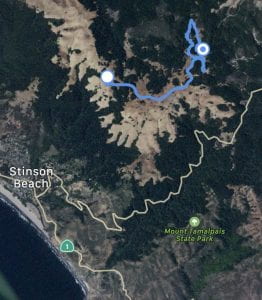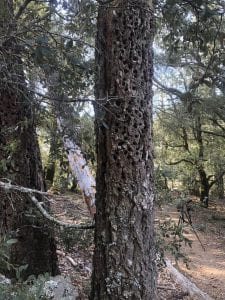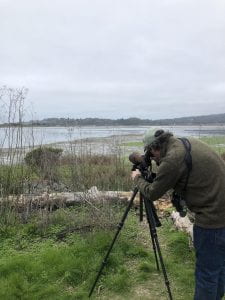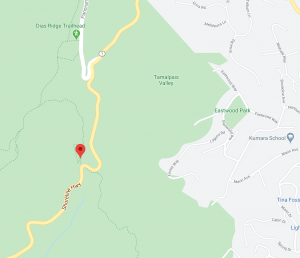Ebird List Link: https://ebird.org/checklist/S64792297
Date: 02/20/20
Location: Rock Springs Mount Tamalpais, Marin County (37.910211, -122.612658) at an elevation of approximately 1,000 feet (304.8 meters). Refer to the map below for where observations were recorded.
Site Description: General topography of the site consisted of numerous hills varying in elevation. Sightings were done continuously along the Rock Springs trailhead. Some sightings were done in denser forest areas, while others were done in more open areas. The habitat would be accurately described as an oak coniferous forest that also had pine trees, Douglass fir trees and moderate varieties of grasses and shrubs. The most abundantly observed species were: Acorn Woodpeckers (18), Dark-eyed Juncos (6), Band-tailed Pigeons (6), and Ruby-crowned Kinglets (4). Other species observed were: Red-shafted Northern Flickers (3), Chestnut-backed Chickadees (3), Common Ravens (2), California Scrub-Jay (1), and Red-tailed Hawk (1).
Species Account: A bird was spotted on the trunk of an oak tree in the shade exhibiting woodpecker-like behavior, drumming into the tree’s trunk. Besides the drumming, the bird did not exhibit any noise or vocalization. I noted that the bird was alone and did not appear to be apart of a flock. The bird remained positioned on the trunk the entire time I observed it, so I was able to get a good view of some of its features. Since the bird was holding onto the trunk, I was unable to view the features on its belly and underside. However, from what I could see the bird had very unique plumage. There were two main things that stood out to me. The first was the bird’s distinct, uniform black stripping that covered its back and wings. The second was the bright red malar on both sides of the face. The bird was identified as a Red-Shafted Northern Flicker. Northern Flickers (Colaptes auratus) are of the order Piciformes and family Picidae. They are large-sized woodpeckers that have brown bodies, black backs, and black spotted chests with a black crescent-shaped mark. Another feature they have that makes them easily identifiable during flight is their white rump. There are subspecies of Northern Flickers which can be distinguished by the color under their wings, for example, the Red-shafted versus the Yellow-shafted. The Yellow-shafted Flickers are found primarily in eastern and northern North America while the Red-shafted Flickers are found primarily in the West south through Mexico. They mainly inhabit open woodland areas where they can ground forage for insects using their slightly-curved bills to dig. The interesting thing to note about this species of woodpecker is that they prefer ground foraging, as compared to tree hammering. However, they do use trees as nests, creating holes in them for their eggs. Northern Flickers utilize tree drumming as a form of communication, along with their loud and piercing yelps. The Northern Flickers are also noted to be one of the few North American Woodpecker species that are strongly migratory, moving south for the winters.

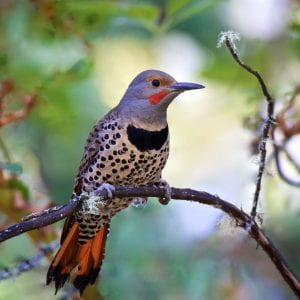
Sources:
- “Northern Flicker.” https://ebird.org/species/norfli
- “Northern Flicker.” https://www.allaboutbirds.org/guide/Northern_Flicker/overview
Narrative: Observations occurred along the Rock Spring trailhead over about 4 miles. The weather was sunny with some winds. The temperature averaged at about 65 degrees Fahrenheit. Over the duration of the trip (150 minutes), nine different taxa were observed. I noted that the diversity of birds was significantly lower than observed at other sites in the past. I also noted that of these nine taxa, we only observed about 44 individuals in total. The abundance of birds observed was also significantly lower than at other sites in the past. I was surprised by this because I expected that numerous amounts of species and individuals would be flourishing in this denser forest environment that contained a vast variety of vegetation. The ecology of the environment would have catered to all sorts of birds, from ground foragers to tree foragers. Throughout our walk along the trail, I noticed that the Acorn Woodpeckers were observed in groups of at least five, but usually more. I also noticed that the Acorn Woodpeckers were extremely vocal, they exhibited a raspy sort of trilling noise in a repetitive fashion. I also heard the call of the Chestnut-backed Chickadee several times, a high-pitched and squeaky undulating sound. Although I didn’t directly observe many of them by eye, their call was very uniquely identifiable.
Additional Photos or Media:
